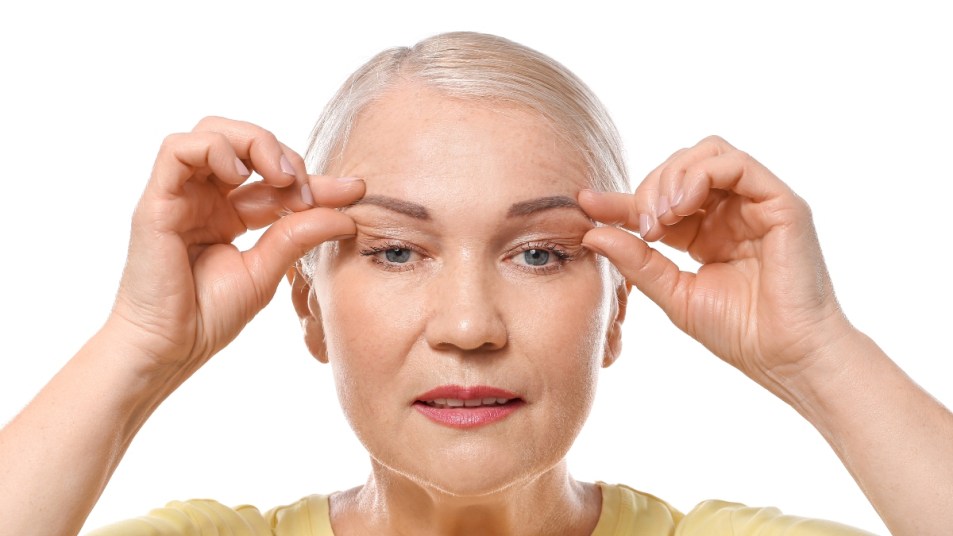Can Face Yoga Plump Sagging Skin and Reduce Wrinkles?
Try these exercises, from forehead smoothing to cheek presses.

You might’ve seen these videos all over social media: women making strange, repetitive facial expressions and using their hands to push and pull their skin. While it’s unclear when and where face yoga originated (some sources suspect it came from Japan), the practice has taken the anti-aging movement by storm. Before-and-after face yoga videos show women whose faces have undergone dramatic changes: their skin looks lifted, toned, and less puffy after diligent facial exercises, or so the users claim. But can face yoga really result in a transformation as impressive as Botox? The short answer: Diligent, long-term practice may indeed yield noticeable changes, such as pronounced cheeks and a toned look. Combining face yoga with gua sha, another anti-aging technique, likely yields even more impressive results. Keep reading to get the full picture.
What is face yoga?
Quite simply, face yoga is facial exercise. It’s characterized by movements, expressions, and techniques that work the muscles in the face. The theory is that strengthening facial muscles lifts and tones the face, fills out the cheeks (the largest facial muscles), and reduces the appearance of wrinkles.
Does research back up the benefits of face yoga?
There is some evidence that face yoga improves “facial fullness” and combats aging. A 2018 study published in JAMA Dermatology tested face yoga on 16 participants between 40 and 65 years of age. After 20 weeks of treatment, which consisted of 30-minutes of facial exercises daily, participants experienced noticeable improvements — including upper and lower cheek fullness, lower cheek fullness. All 16 participants were highly satisfied with the results.
Another 2018 study published in the Japanese Journal of Geriatrics investigated other potential benefits of face yoga (not just aesthetic ones). The research involved 53 participants between 65 and 87 years of age. Some participants completed a facial exercise program — two 30-minute sessions daily — for 12 weeks, and other participants were in a control group (they didn’t do facial exercises). At the end, the researchers concluded that daily facial exercise sessions improved mental health, facial expression, and tongue muscle power, all of which are linked to longevity.
On the other hand, a 2013 scientific review of multiple facial-exercise studies determined that we need more evidence to prove face yoga’s benefits. The review authors argued that studies prior to 2013 were too small and didn’t control for confounding variables. (A confounding variable is one that could influence the results of the study. Such a variable would make it unclear whether face yoga was the only reason participants’ facial features improved.)
While the 2018 Japanese Journal of Geriatrics study had a control group, the 2018 JAMA Dermatology study did not. So, we have some evidence that face yoga has anti-aging and health benefits, but we need more research to back up these theories.
What are the most common face yoga techniques?
If you’re interested and want to try out a few techniques yourself, check out these exercises recommended by face yoga experts.
Smooth Forehead
Take the palm of your right hand and smooth it from left to right over your forehead. Repeat the movement on your left hand (smooth your forehead from right to left). Use enough pressure to gently push across your forehead, but not so much that you are pulling your skin.
Purpose: This technique is designed to reduce tightness and muscle tension, preventing fine lines and wrinkles. It also improves circulation to the area.
Cheek Presses
Hold up your pointer and middle fingers on both hands. Press your fingers gently into your cheekbones, just under the apples of your cheeks. Then, lift off. Press and lift all along your cheeks, from the outer corners of your lips up towards your ears.
Purpose: This movement is designed to stimulate your cheek muscles and boost circulation.
Eye Strengtheners
Press the palm of your hand into your forehead. Without moving your forehead, flick your gaze up and to the right, then look down. Flick your gaze up and to the left, and look down. Repeat this eye movement for a full minute.
Purpose: This exercise helps retrain your facial muscles to use your eyes more and your forehead less — the idea being that stronger eye muscles will prevent you from wrinkling your forehead.
Neck Stretch
Interlace your fingers, palms facing inward. Push your hands away from you, so your arms straighten — you may feel a slight stretch in your shoulders. Look down; the stretch should deepen. Then, slowly move your chin up and to the left, at a 45 degree angle. Pause and take a few breaths, then move your chin back down to center. Slowly move it up and to the right, pause, then move it back down to center. Repeat for two minutes.
Purpose: This movement stretches the muscles in your neck, which eases tension in your face. Overtime, it also helps improve your neck posture.
Why should you pair face yoga with gua sha?
While face yoga may help strengthen your facial muscles, relax tension, and increase cheek fullness, it isn’t the only anti-aging technique. Gua sha — a massage technique using a gemstone facial tool — promotes lymphatic drainage, eases puffiness, and reduces inflammation. Overtime, these benefits may give the face a more “sculpted” look. Interested? Check out this gua sha tutorial.
What’s the bottom line?
While face yoga probably won’t create the dramatic changes you’re hoping for, it has no harmful effects. (Unless you count the embarrassment of making those facial expressions in front of friends or family!) If you practice diligently and add gua sha to your routine, you might even be satisfied enough to avoid botox.












